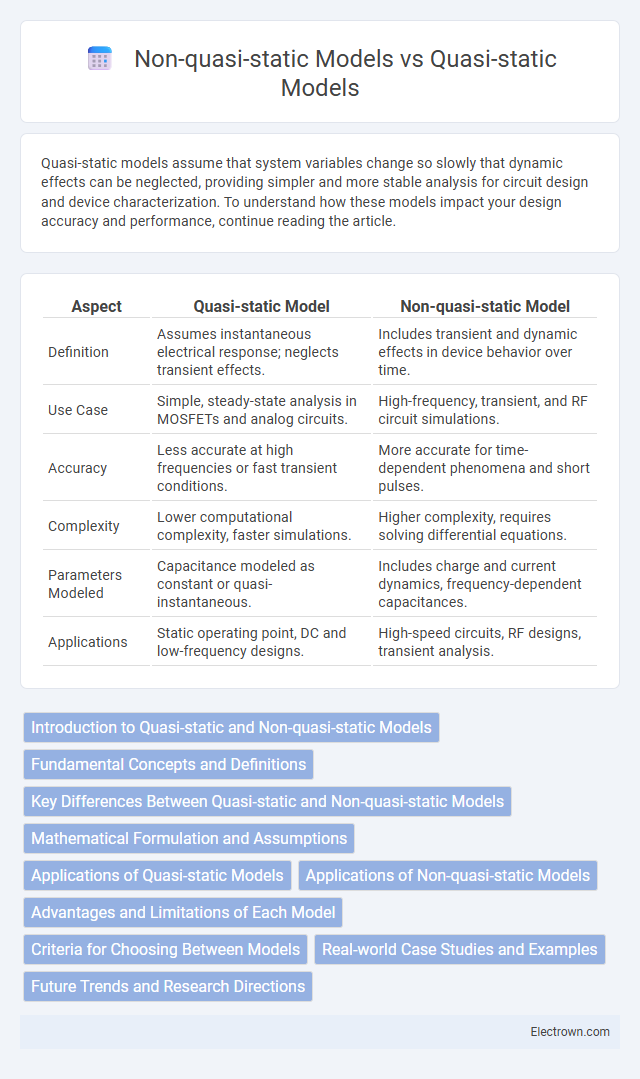Quasi-static models assume that system variables change so slowly that dynamic effects can be neglected, providing simpler and more stable analysis for circuit design and device characterization. To understand how these models impact your design accuracy and performance, continue reading the article.
Table of Comparison
| Aspect | Quasi-static Model | Non-quasi-static Model |
|---|---|---|
| Definition | Assumes instantaneous electrical response; neglects transient effects. | Includes transient and dynamic effects in device behavior over time. |
| Use Case | Simple, steady-state analysis in MOSFETs and analog circuits. | High-frequency, transient, and RF circuit simulations. |
| Accuracy | Less accurate at high frequencies or fast transient conditions. | More accurate for time-dependent phenomena and short pulses. |
| Complexity | Lower computational complexity, faster simulations. | Higher complexity, requires solving differential equations. |
| Parameters Modeled | Capacitance modeled as constant or quasi-instantaneous. | Includes charge and current dynamics, frequency-dependent capacitances. |
| Applications | Static operating point, DC and low-frequency designs. | High-speed circuits, RF designs, transient analysis. |
Introduction to Quasi-static and Non-quasi-static Models
Quasi-static models describe systems under the assumption that changes occur slowly enough for the system to remain in equilibrium at all times, making them ideal for analyzing steady-state or low-frequency behaviors. Non-quasi-static models capture transient and high-frequency effects by accounting for time-dependent dynamics and inertial forces, providing deeper insight into rapid system responses. Your choice between these models depends on the specific application and accuracy required for predicting system behavior under varying temporal conditions.
Fundamental Concepts and Definitions
Quasi-static models assume that circuit variables change slowly enough for the device to remain in near-equilibrium, allowing simplification of transistor behavior using steady-state equations. Non-quasi-static models account for rapid transient effects and carrier transport delays, providing more accurate representation under high-frequency or fast-switching conditions. Fundamental understanding hinges on the temporal scale of signal variations relative to carrier response times, defining each model's applicability in semiconductor device simulations.
Key Differences Between Quasi-static and Non-quasi-static Models
Quasi-static models assume that changes occur slowly enough for the system to remain in near-equilibrium at all times, allowing simplification by neglecting dynamic effects. Non-quasi-static models capture transient behaviors and time-dependent phenomena, making them essential for accurately simulating fast-switching circuits and high-frequency applications. Understanding these key differences helps you choose the appropriate model for precise analysis and design optimization in electronic simulations.
Mathematical Formulation and Assumptions
Quasi-static models assume that system variables change slowly enough to neglect dynamic effects, using algebraic equations to describe steady-state relationships derived from simplified assumptions like time-invariant parameters. Non-quasi-static models incorporate time-dependent differential equations to capture transient behaviors and rapid variations, accounting for inertial and capacitive effects often ignored in quasi-static approaches. Understanding these mathematical formulations and their underlying assumptions helps you select the appropriate model based on the temporal resolution and accuracy required for your system analysis.
Applications of Quasi-static Models
Quasi-static models are extensively used in semiconductor device simulations, particularly for MOSFETs under low-frequency or DC operating conditions where the assumption of instantaneous response to voltage changes holds true. These models provide accurate predictions for device characteristics in analog circuit design, enabling reliable analysis of transistors' static behavior without considering transient effects. Quasi-static modeling is crucial in the development of integrated circuits for applications such as amplifiers, sensors, and low-speed digital circuits where delay and dynamic effects are minimal.
Applications of Non-quasi-static Models
Non-quasi-static models are essential in accurately simulating high-frequency and high-speed transistor behavior where rapid transient effects dominate, such as in RF circuits and millimeter-wave amplifiers. These models capture carrier delay and charge partitioning, which impact dynamic performance in analog and mixed-signal IC design, including power amplifiers and high-frequency mixers. Their application enhances precision in predicting device characteristics under fast switching and varying bias conditions, critical for modern high-speed communication systems.
Advantages and Limitations of Each Model
Quasi-static models offer high computational efficiency and simplicity by assuming steady-state conditions, making them ideal for circuits with slow or negligible transient effects, but they lack accuracy in capturing fast dynamic behaviors and high-frequency phenomena. Non-quasi-static models provide precise simulation of transient and high-frequency effects by incorporating time-dependent charge transport and carrier dynamics, resulting in more accurate device behavior predictions, though they demand significantly higher computational resources and complexity. Selecting between these models depends on the trade-off between simulation speed and accuracy requirements in semiconductor device analysis.
Criteria for Choosing Between Models
Criteria for choosing between quasi-static and non-quasi-static models center on the time scales of device operation and signal variation. Quasi-static models are appropriate when the device response is significantly faster than the input signal changes, ensuring that transient effects are negligible. Non-quasi-static models become necessary when high-frequency operation or rapid transient events induce significant charge carrier delay or velocity saturation effects, affecting accuracy in RF and high-speed digital circuits.
Real-world Case Studies and Examples
Quasi-static models are widely used in power electronics to simulate steady-state behavior, such as in DC-DC converters for electric vehicles, where load variations occur slowly and thermal effects are minimal. Non-quasi-static models excel in high-frequency switching applications like RF amplifiers and high-speed integrated circuits, capturing transient phenomena and parasitic capacitances that impact signal integrity. Real-world case studies in semiconductor device design demonstrate that non-quasi-static modeling significantly improves accuracy in predicting device performance under rapid switching conditions, crucial for optimizing next-generation communication systems.
Future Trends and Research Directions
Future trends in quasi-static vs non-quasi-static models emphasize developing hybrid approaches that integrate real-time dynamic analysis with traditional static frameworks for enhanced accuracy in device simulation. Research directions explore machine learning algorithms to predict non-quasi-static behaviors efficiently, enabling improved modeling of transient effects in advanced semiconductor devices. Your adoption of these emerging techniques can significantly optimize performance prediction and facilitate innovation in electronics design.
Quasi-static vs Non-quasi-static Models Infographic

 electrown.com
electrown.com